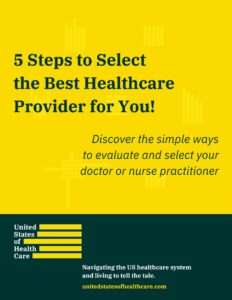Your Personal Health Record (PHR): A Guide to Maintaining Health History

Most likely, to maintain a record to track your finances, you access online banking apps which track your spending and banking history. But if you’re like most people, you probably don’t keep digital records of your personal health information or that of your loved ones. If you don’t, it’s a good time to start! Maintaining your own Personal History Record can keep you healthy, help you in emergencies, and allow your loved ones to help manage your care.
What is a Personal Health Record (PHR), and Why is it Important?
You may have heard of the terms medical record, electronic health record (EHR), and electronic medical record (EMR). These are all examples of a digital history of your health and healthcare-related information kept by your healthcare providers. With your help, your doctors and other clinicians maintain and secure these records.
A personal health record, however, is your very own digital record that you gather and maintain yourself. According to the U.S. Centers for Medicaid and Medicare Services (CMS), a “Personal Health Record (PHR) is controlled by the individual, and can be shared with others, including caregivers, family members, and providers.”
In this way, an EHR maintained by a person’s healthcare provider is different from a PHR. While the EHR requires your permission for your provider to share the information, you can share a PHR with anyone you wish, at any time — especially in an emergency.
What’s In a Personal Health Record?
Contrary to what many people believe, a PHR is more than a list of your current medications, though that’s also essential. The following are a few items you may want to include in your PHR.
Contact Information
- Physicians and specialists you’re currently working with, along with their contact numbers.
- Family contact numbers.
Legal Information
- Your insurance information.
- Legal considerations, if applicable, like a living will, advanced directives, medical POA, or proxy.
Medical History
- Your allergies and sensitivities, and what occurs if exposed (rash, difficulty breathing).
- Your exercise and dietary habits, especially if you have a special diet.
- Current medications with dosages, including over-the-counter medicines and supplements.
- Dates of your past surgeries or hospitalizations.
- Current diseases or diagnoses, especially chronic conditions like heart disease or diabetes.
- Test results, including x-rays and MRIs.
- Your family’s physical and mental health history.
- Immunizations, along with dates.
- Upcoming appointments, especially if they’re far in advance.
- Home data (blood pressure readings, blood sugar test results, etc.)
Social Information
- Language considerations or disabilities could create a communication barrier.
- Religious considerations.
Family History In Your Personal Health Record
Your family history is a vital part of your health record for various reasons. For example, the genes passed down through your family can influence whether or not you have a tendency to develop a specific disease. In addition, some conditions depend entirely on a person’s family history. Hemophilia and sickle cell anemia are examples of diseases that are passed on by family genetics.
Perhaps more importantly, families are often exposed to the same environments, both physical and emotional. Families tend to eat the same foods, live in the same area, and experience shared experiences. Therefore, knowing your family’s health history provides clues to your future health.
Commonly Used Functions of a PHR
A PHR can be, quite literally, a lifesaver.
In an emergency, a PHR serves as immediate information for first responders. Rather than guessing, a first responder may utilize a PHR to find drug allergies, medical history, and contact information.
Your PHR also captures your basic healthcare information in one area, mainly if you see many providers who utilize different EHR systems. When you use a PHR, all your basic health information is in one place.
When you gather your health information for your PHR, you’ll find that you begin to organize and understand your healthcare a little more. Why? Because a PHR empowers you to track and assess your health independently. After all, your healthcare doesn’t stop in between doctor’s visits. In the end, you are responsible for your healthcare. A PHR helps you stay on track and meet your healthcare goals.
PHRs, EHRs, and Patient Portals: What’s the Difference?
A PHR is not the same as an EHR. And PHR and EHR are not the same as a patient portal. A patient portal allows you to have digital access to portions of your EHR maintained by your healthcare provider. Think of the patient portal as a doorway into select parts of your health record that is connected to a specific healthcare provider.
Because it’s kept by the provider, an EHR may have extensive medical information and technical jargon. A PHR, on the other hand, is maintained by you and contains considerably less information. You may have a binder or file folder at home with hard copy information, which could function as a PHR. However, most often, a PHR is digital rather than paper.
The good news is that many EHRs have PHR components within the system, accessible through a patient portal (doorway). Patients can often add their home blood pressure readings or blood sugar data to their PHR through the patient portal.
How Do I Create a Personal Health Record?
Creating your PHR may seem overwhelming at first, but it’s worth it in the long run. If your healthcare provider utilizes an EHR, you may choose to take advantage of the connected personal health record function.
The following are some links to a few patient portals that you may come across:
Your provider may have an app to function as a patient portal. Two common examples are MyChart and FollowMyHealth. You can also use your own digital PHR through free options online, like HealthSpek.
Typically, you’ll need to create an account before utilizing the patient portal and PHR functions. Some patient portals require an email address or a mobile phone number. If you’re unfamiliar, the staff at your healthcare provider should be able to assist you. Once you’ve logged in through the portal, you’ll have access to the PHR and EHR functionality.
Does HIPAA Apply to PHR?
Because a PHR contains your medical information, you probably wonder if HIPAA applies to PHR. In short, the answer is yes. A PHR offered by a healthcare provider or a health plan is subject to both state and federal laws governing privacy, such as HIPAA.
What are the Pros and Cons of Personal Health Records?
Having a PHR empowers you to track and organize your healthcare information. With a PHR, you can:
- Assess and track your healthcare
- Prepare and review visits with your provider
- Analyze your healthcare data, like blood pressures and blood sugar readings
- Organize your healthcare information so that it’s readily available in one place
Like any other technology-related tool, customizing and familiarizing yourself with any PHR system takes time. The following are a few other drawbacks to having a PHR:
- Building and maintaining PHR can be time-consuming
- If your PHR is not part of a patient portal, you may have to input information yourself
- You must maintain and update your PHR to keep it accurate
- Hackers may breach digital data
The benefits far outweigh the drawbacks, however, and tracking your physical and mental health and your financial health can improve your quality of life!
Maintaining Your PHR
As with most things in life, momentum can die down. However, after starting a PHR, stay motivated to maintain the information and keep it current. Review your PHR periodically for accuracy. Set a regular ritual, For example, update your PHR after each visit to your healthcare provider or when you are paying your monthly bills. The more you can integrate tracking your health into your regular routines the better.
Make the Change to a Digital Personal Health Record
You’re more likely to utilize information if convenient, and a PHR is much more convenient than paper-based healthcare information you keep in a file at home. You’re more likely to review and update your information in the PHR — once you’ve become familiar with the system — than on hardcopy. In addition, you can analyze your healthcare information at a glance with a PHR. Many digital PHRs offer analytics to graph or study your lab tests and vital sign readings, which is something a paper-based PHR can’t do. There’s never a better time than now to take control of your healthcare, and a PHR can help you do just that.
If you’d like more information about the healthcare process, visit our United States of Healthcare resource page. Please let us know what other types of healthcare-related information you’d like to read about, and sign up for our blog for future articles.

